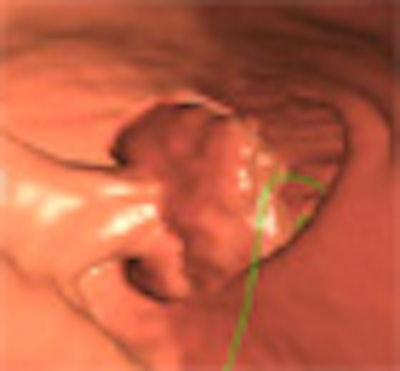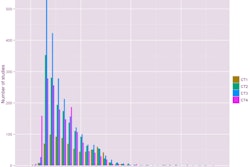
Moving patients efficiently through a high-volume virtual colonoscopy practice means getting ready for plenty of same-day colonoscopies for patients presenting with polyps, according to U.S. military researchers who spoke earlier this month at the Digestive Disease Week meeting in Chicago.
Importantly, the research team from the National Naval Medical Center (NNMC) in Bethesda, MD, said that even when a single polyp 6 mm or larger triggers a referral for same-day colonoscopy, the referral rate is modest in a cohort of patients receiving virtual colonoscopy (also known as CT colonography or CTC).
"We see about a 10% test-positive rate, and that makes CTC a very viable option," said Dr. Brooks Cash, NNMC's chief of gastroenterology in an interview with AuntMinnie.com. "If it was 25% to 30%, it wouldn't be cost-effective."
The center's high-volume practice, which screens military personnel as well as their families, initiates screening at age 45 in African-Americans and at age 50 in other patients. Screening typically continues until about age 75, "although we do screen older patients in special circumstances based on patient and clinician input," he said. Most are asymptomatic.
Setting up an efficient virtual colonoscopy practice means procuring and coordinating myriad resources to keep everything moving smoothly.
But what's important? Based on the experience of the screening practice launched in 2004 at NNMC, study authors Cash, Dr. James Duncan, Dr. Obinna Ugochukwu, and colleagues from the University of Massachusetts in Worcester aimed to identify the factors that optimized the virtual colonoscopy experience for both staff and patients.
The goal was to devise the ideal efficient colorectal cancer (CRC) screening program that would offer same-day optical colonoscopy based on abnormalities detected at CTC, they said.
Doing so meant identifying the expected number of patients who would require colonoscopy based on CTC findings; determining the time required to complete both procedures in a same-day, outpatient setting; and optimizing resource allocation/staffing to support an efficient CTC screening program, the group stated.
They reviewed data from an institutional quality assurance database on all CTC exams performed from 2004 through 2010. From this, a sample population was extrapolated that required colonoscopy based on CTC findings. The researchers looked at the amount of time spent from arrival for CTC to discharge after optical colonoscopy, and they identified procedural events that occurred during the patients' wait time.
Complete data were obtained from a subset of 130 patients with abnormal CTC who underwent same-day optical colonoscopy.
In all, 10,152 CTC examinations were performed during the study period, 11% (1,137) of which required an optical colonoscopy referral, the team reported. The mean age at screening was 56.4 years, and approximately 98% of participants were asymptomatic screening patients.
All underwent fecal and fluid tagging as part of a "wet" bowel prep based on polyethylene glycol (PEG). The PEG-based prep, preferred by gastroenterologists performing optical colonoscopy, is also well-accepted by the radiologists reading virtual colonoscopy at the facility, Cash said.
From the 130-patient sample, sensitivity was calculated at 95% for lesions larger than 5 mm, with a false-positive rate of 3%. For lesions 8 mm or larger, sensitivity was 99%, with a false-positive rate of 0.8%.
 |
| Colonoscopy results in a subset of 130 patients showed low rates of false negatives and false positives at CTC. Image courtesy of Dr. Brooks Cash. |
For patients who underwent CTC followed by same-day colonoscopy, the average wait time was 348 ± 100 minutes (median, 333 minutes) -- a little on the long side because the process has involved a learning curve, Cash said.
The approximate six-hour average wait time for patients undergoing both CTC and optical colonoscopy is "a little bit deceptive in that this spans the last seven years of CTC practice, and we had higher numbers when we were starting out," he said. The results represent "lessons learned." Currently, "I think our average time is down to about three hours" if somebody is found to need colonoscopy, he added.
Factors influencing patient wait time for same-day optical colonoscopy include the following:
- Patient arrival and check-in
- Patient prep for procedure
- Radiologist CTC interpretation
- Endoscopy unit registration time
- Optical colonoscopy setup and completion time
- Discharge time from optical colonoscopy recovery
About one in 10 CTC patients will be referred for optical colonoscopy -- a very reasonable referral rate considering that individuals with even one 6-mm polyp detected at CTC are referred for same-day colonoscopy.
Except for patients in a small surveillance study being performed in cooperation with the University of Wisconsin-Madison, polyp surveillance is not part of the NNMC protocol, Cash said.
Outside the research setting, "we don't recommend it," he told AuntMinnie.com. "There is relatively abundant data as it exists right now that demonstrates about a 15% advanced histology rate and 0.5% to 1% cancer prevalence in 6- to 10-mm polyps. A 1% cancer prevalence is still too high in our minds to recommend surveillance," he said.
As for diminutive polyps 5 mm and smaller, "we have less understanding but the data are reassuring" that advanced histology is quite rare, Cash said.
In any case, the joint one-year polyp surveillance study under way with Dr. Perry Pickhardt's group in Wisconsin is expected to provide solid outcomes data on patients with 6- to 9-mm lesions, Cash said.
As for practice efficiency, future study efforts will focus on identifying areas for interventions to streamline the process, shorten wait times, and create a more efficient screening program, Cash said.




















